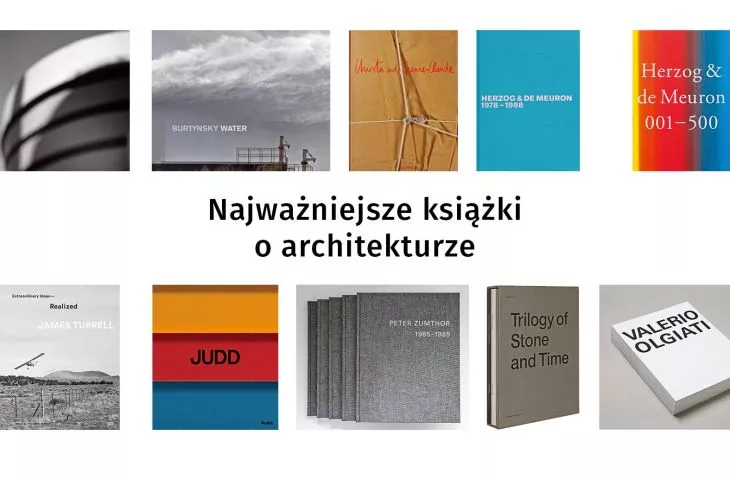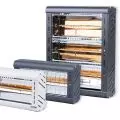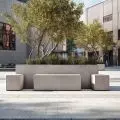From the series "The most important books on architecture".
There are some books that are an endless source of inspiration, motivation and reading sighs. They are beautifully published, tell interesting stories, show the passions of their authors. In a word - they draw you in. Today, the first tale of important books according to Bartosz Haduch [{tag:Studio}] - an architect, researcher, university teacher, traveler and curious man who is connected with books not only as an enthusiast and reader, but also as an author.
Booklist:
- "Architecture"
Hiroshi Sugimoto - "Burtynsky.Water"
Edward Burtynsky - "Christo and Jeanne Claude"
Christo and Jeanne Claude, Wolfgang Volz, Paul Goldberger - "Herzog & de Meuron.Complete Works "
Herzog & de Meuron, Gerhard Mack - "Herzog & de Meuron 001-500"
Dino Simonett - "James Turrell.Extraordinary Ideas - Realized"
James Turrell, Lorraine Wild, Florian Holzherr - "Judd"
A. Temkin, E. Cooke, T. Margalit, Ch. Mehring, J. Meyer, A. Ochmanek, Y. Raymond, J. Weiss - "Peter Zumthor 1985-2013 Buildings and Projects."
Peter Zumthor, Thomas Durisch - "Trilogy of Stone and Time"
Klaus Merkel - "Valerio Olgiati"
Valerio Olgiati, Laurent Stadler, Bruno Reichlin, Mario Carpo
1. "Architecture"
Author: Hiroshi Sugimoto
Publisher: Damiani
Bologna 2019
In 1997, Hiroshi Sugimoto began a series of photographs of famous buildings (mostly iconic 20th and 21st century realizations, known from textbooks and numerous publications), intending, as he explains, to "trace the beginnings of a new era through the architecture that defines it." The conclusion of this series is the album "Architecture", released last year, containing 90 photographs (including 19 previously unpublished) depicting buildings designed by Le Corbusier, Mies van der Rohe, Frank Lloyd Wright, Luis Barragán, Peter Zumthor, Tadao Ando, Frank Gehry or the duo Herzog & de Meuron, among others.
The pictures presented in it were created in places with which the artist is connected: Japan (he was born there) and the United States (he lives and works there), but many of them were taken during his numerous travels, mainly in Europe.
One of the characteristics of most of Sugimoto's works is their technical precision within the use of analog means. Behind each of his series ("Seascapes," "Revolution," "Dioramas," "Portraits," "Sea of Buddhas" "Conceptual Forms and Mathematical Models" and "Theaters") is an original idea, so he is often counted among conceptual artists. He photographs exclusively with an 8×10-inch large-format camera, and the final developed gelatin-silver prints impress with their ideal tonal range, almost complete lack of grain, richness of detail and overall optical precision. Embarking on a years-long process of documenting architecture, Sugimoto decided to revise his habits and began taking photographs in exactly the opposite way than before. "Moving the focal length of my camera to double infinity, I discovered that excellent architecture can survive the act of deliberately blurring the image. In this way, I began to test selected buildings for their longevity, watching them slowly melt through the process of photographic erosion and reveal their essence." Sugimoto thus reduces architecture to its essence and the beginning of the creative process with the help of black-and-white blurred photographs, trying to reproduce the first, not yet fully specified "vague" vision formed in the architect's head. It is not yet "contaminated" by compromises, technological limitations, or workmanship imperfections. Sugimoto's photographs are also a perverse play with repeatedly reproduced views of well-known buildings, fixed in the popular consciousness. It's like the depictions of Rouen Cathedral painted by Claude Monet - the image presented by the artist is not an attempt to faithfully reproduce reality, but rather an interpretation, an impression and a pretext to activate memories, comparisons and imagination.
The "Architecture" series can be seen as a continuation of Sugimoto's long-standing research on the passage of time and history, but also a reference to the passion he indulges in his spare time. Indeed, the artist is the author of several interesting architectural projects, including the Go-Oh temple on Naoshima Island (2002), the Mondrian glass tea pavilion (exhibited at the 2014 Venice Architecture Biennale and a monographic exhibition at Versailles in Paris in 2014) and a collector's apartment in New York's 432 Park Avenue skyscraper (2018). Sugimoto's most important architectural and photographic project, however, is an observatory in the Japanese town of Enoura (which is also the headquarters of the Odawara Art Foundation, founded by the artist), where astronomical phenomena associated with the summer and winter solstices can be viewed. Two recent photos in the Architecture album, taken in the fall of 2018, show this very special place.
***
















































